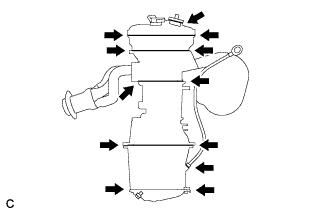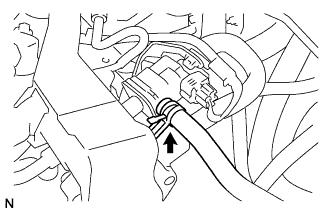Emission Control System -- On-Vehicle Inspection |
| 1. INSPECT FUEL CUT OFF/RESTART RPM |
Start and warm up the engine.
Increase the engine speed to at least 2500 rpm.
Use a sound scope to check for injector operating sounds.
When the accelerator pedal is released, check that injector operating sounds stop momentarily and then resume.
- Standard:
Item Specified Condition Fuel cut off rpm 2500 rpm Fuel injector restart rpm 1200 rpm
| 2. VISUALLY INSPECT HOSE, CONNECTIONS AND GASKETS |
Visually check that the hoses, connections and gaskets have no cracks, leaks or damage.
- NOTICE:
- Detachment or other problems with the engine oil dipstick, filler cap, ventilation hose and other components may cause the engine to run improperly.
- Air suction caused by disconnections, looseness or cracks in any part of the air induction system between the throttle body and cylinder head will cause an engine failure or engine malfunction.
 |
| 3. INSPECT EVAPORATIVE EMISSION CONTROL SYSTEM |
Connect the intelligent tester to the DLC3.
Disconnect the fuel vapor feed hose from the purge VSV as shown in the illustration.
Start the engine.
Enter the following menus: Powertrain / Engine and ECT / Active Test / Activate the VSV for Evap Control.
 |
Check that vacuum occurs at the purge VSV port.
If vacuum does not occur, check the following items.- Purge VSV
- Clogging in the fuel vapor feed hose connecting the intake manifold and purge VSV
- Voltage at the ECM PRG terminal
- Purge VSV
Exit Active Test mode and reconnect the fuel vapor feed hose.
Enter the following menus: Powertrain / Engine and ECT / Data List / EVAP Purge VSV.
Warm up the engine and drive the vehicle.
Confirm that the purge valve opens.
If the result is not as specified, replace the purge VSV, wire harness or ECM.
| 4. INSPECT CANISTER |
Close port C, apply compressed air to port A and check that air flows out from port B.
If the result is not as specified, replace the fuel suction plate sub-assembly.
 |
Close port C, apply compressed air to port B and check that air flows out from port A.
If the result is not as specified, replace the fuel suction plate sub-assembly.
 |
Apply compressed air to port B and check that air flows out from port A and port C.
If the result is not as specified, replace the fuel suction plate sub-assembly.
 |
Close ports A and C, and apply compressed air to port B to check for leaks.
If the result is not as specified, replace the fuel suction plate sub-assembly.
 |